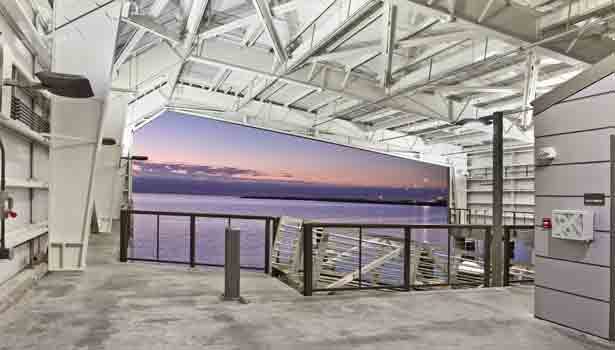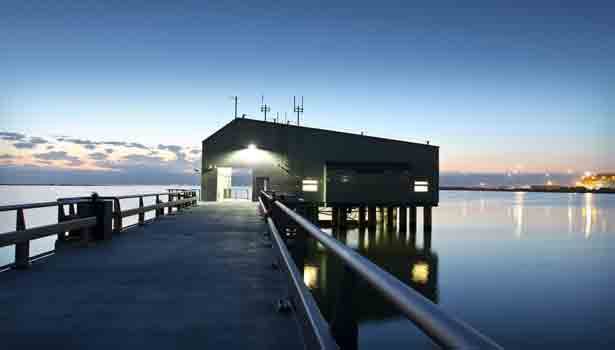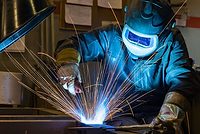Boathouse Stays Shipshape with Protective Coatings








Nestled on the bayside north of the San Francisco International Airport (SFO) is a covered boathouse with the official title of Marine Emergency Response Facility (MERF). As its name implies, the boathouse is part of the airport's emergency preparedness plan in the event of a marine rescue involving an aviation water contact accident.
The Federal Aviation Administration (FAA) requires that airport officials responsible for emergency preparedness plans include a section on water rescue operations wherever approach and departure patterns are in proximity to significant bodies of water. As the first facility of its kind at any U.S. airport on the West Coast, the $5.2 million MERF reportedly exceeds the FAA's safety requirements.
The SFO Bureau of Design and Construction, Architecture Department designed the over-the-water boathouse for launching and storage of marine rescue vehicles including a 44-foot Moose boat, 27-foot Boston whaler, 18-foot Zodiac, and jet skis. The MERF also houses a command center with direct links to emergency services facilities operated by the SFO and City of San Francisco.
Prior to dedicating the MERF in August of 2012, airport officials estimated the response time for firefighters to launch a rescue vehicle from a trailer at 15 to 25 minutes. That response time has been shaved to less than five minutes with the completion of the boathouse, airport officials claim.
After several months in operation, the MERF has provided a staging area for training exercises with SFO rescue units, as well as neighboring jurisdictions including the U.S. Coast Guard. The metallic structure has also maintained its aesthetic appearance, in part due to the high-performance coating system from Tnemec.
"Anytime coatings are used along the waterfront, there's a potential for corrosion," according to Tnemec Sales Representative Wendy Amos of San Francisco-based Amos And Associates. "In addition, this environment is not conducive to applying protective coatings due to the weather and salt air. The architects required all of the coatings on the interior steel to be shop-applied."
Specifications required interior steel to be prepared in accordance with SSPC-SP6/NACE No. 3 Commercial Blast Cleaning and shop-primed with Series 90-97 Tneme-Zinc, an advanced technology zinc-rich urethane coating.
"We have used Tneme-Zinc as our high-performance primer of choice for several years," explained Nick Joaquin, Senior Estimator, R&B Protective Coatings. "We are always delighted when it is called out in the specifications, which is quite often. That was the case with the SFO boathouse."
Amos echoed Joaquin's view on the use of zinc-rich primers. "In our specifications," she noted, "we often suggest that the zinc primer be applied in the shop, because it is much more cost effective and you're in a controlled environment, so you don't have the outdoor temperatures and salt air to contend with."
Other shop-applied coatings included an intermediate coat of Series L69 Hi-Build Epoxoline II, a polyamidoamine epoxy coating, and a finish coat of Series 1075 Endura-Shield II, a high-build aliphatic acrylic polyurethane coating. Both coatings are highly resistant to abrasion, wet conditions, corrosive fumes and exterior weathering.
Interior galvanized steel was prepared in accordance with SSPC-SP16 Brush-off Blast Cleaning of Non-Ferrous Metals. The steel was shop-primed with Series L69 and topcoated with Series 750 UVX, advanced-technology polyurethane finish coat that offers superior color and gloss retention for long-term aesthetics.
A two-part coating system was field-applied to galvanized metal guard rails that are subject to UV light. Applicators brush-and-roller-applied a prime coat of Series 135 Chembuild, a polyamidoamine epoxy, and followed with a topcoat of Series 1078 Fluoronar Metallic, a high-solids fluoropolymer coating with a metallic finish.
SFO architects have a history of specifying Tnemec's flagship fluoropolymer finish coat for other projects on the terminal side, including parts of its extensive public art installation project.
Architects specified shop preparation and coating of a 32-foot-tall polychromed steel sculpture created by famous Mexican artist, Rufino Tamayo, which was originally commissioned in 1983 for display at the Airport's Terminal 2. "The sculpture had been in storage for several years prior to its restoration and placement outside the airport's International Terminal," Amos recalled.
Titled Conquest of Space, the 5,700-pound sculpture of red and blue triangular shapes had faded over time and was corroded around its base. Amos recommended a prime coat of Series 90-97, an intermediate coat of Series 1075, and a finish coat of Series 1072V Fluoronar, a fluoropolymer coating in Blue Print and Chili Pepper Red.
"This system is our choice for color and gloss retention," Amos explained. "Since a bright red color was involved, color retention was a major consideration. And because the sculpture was located outside, it needed a finish coating that offers long-term performance."
All restoration and recoating work was completed under controlled shop conditions. The restored sculpture was then transported to the International Terminal where a crane was used to position it onto a concrete base.
The SFO public art collection was acquired over a 30-year period under the leadership of the San Francisco Arts Commission. In the Catalogue of Permanent Public Art at San Francisco International Airport, the sculpture is recognized as Tamayo's first sculpture to be permanently placed outside of Mexico.
Looking for a reprint of this article?
From high-res PDFs to custom plaques, order your copy today!












